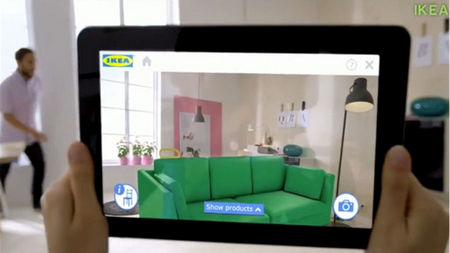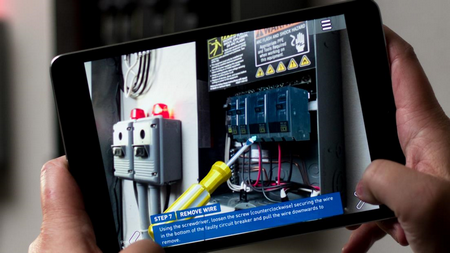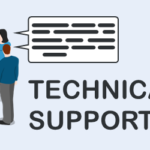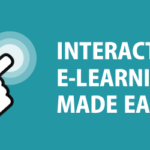Excellent post, Tom, as always. Very thought-provoking and well researched – much appreciated.
The Future of E-Learning
May 15th, 2018
Here’s an excerpt from a recent presentation on the future of learning technology.
I went to school to be a video producer. Right after I graduated, the video industry changed from analog to digital. At the time digital video technology was cutting-edge and super expensive. And I was stuck in a job with an organization that had no money, so I felt that everything was was passing me by and I’d never catch up.
I see a lot of the same things in our industry today. So much is changing and it’s hard to keep up. It can be quite stressful.
We’ll look at some emerging technologies and how they impact our jobs and then how it really impacts you.
E-Learning Democratized

A few years back, it was expensive to build e-learning courses. That changed with the PowerPoint-to-Flash tools like Articulate Studio. Those tools let all organizations into the e-learning world and made it possible to bring course content to the masses.
Over time, the tools evolved as we went from PowerPoint to Storyline.
E-Learning Made Easy

It took a lot to build web pages a few years back. Now you have sites like Wix where you can build a pretty sophisticated site in minutes. The same thing is happening with e-learning. Look at how easy it is to build a course in Rise.
There are the naysayers who complain about this. I actually had someone tell me that we should limit access to the software to only people with the training to build courses. That may have worked in the Soviet Union, but I prefer a less elitist approach. Give them the tools and then help them learn to use them better is a more charitable approach.
Besides, organizations will always opt for quicker, cheaper delivery (especially when most of their courses are explainer-type content).
Virtual Reality is Virtually Here
One emerging technology is virtual reality (VR). When done right it can create truly immersive experiences. I’ve seen some really cool demos and it’s definitely going to create opportunities for different ways to learn.
With that said, many of the virtual reality demos I see are simple 360° videos with clickable hotspots. They’re not much more than labeled graphics. There is a novelty to them, but it seems like a lot of work to create video labeled graphics. Not sure how much more valuable they are than static images once you get past the novelty of viewing them.

The real value in virtual reality is being able to interact with the environment and not just move around and click for information, like in the images above where you work in a simulated dental office.
The reality (that’s not virtual) is that building an immersive virtual environment is cost prohibitive for most organizations. Until the costs to produce come way down, for most organizations virtual reality will be a pipe dream.
Augmented Reality is a More Affordable Reality
With augmented reality (AR) a lot of the cost of production is reduced. Instead of trying to create a virtual world, we augment the real world with additional content and experiences.

Ikea and other sites allows us to put furniture in real rooms to see how it will fit.

We can use our phones to translate content in real time or learn what’s around us.

And we can learn new things, just in time at our point of need.
If you want to play around with augmented reality, check out HP Reveal and learn more about what some of the tech leaders are doing:
The Technology That Will Really Change Your Job
Virtual and augmented realities are cool and obviously have a role in our industry, but the technologies that will really change your jobs are artificial intelligence (AI) and big data.

- Look at how the marketing world already uses data. They know who you are, where you’re at, and what interests you. And they use that to send all sorts of information. Essentially they’re learning to serve you the content you want.
- Your phone already reviews your messages and emails and can craft appropriate responses.
- Chatbots are designed to interact with you and deliver the right content.
- Here’s Google Assistant making calls for you while you sit at home binge watching your favorite shows.
- AI is already crafting hundreds of articles and news pieces. Maybe we’re onto something. The fake news is coming from fake people.

Most of what drives e-learning is compliance and regulatory training. Often, we’re just rehashing content that already exists someplace else. Soon, that’ll all be automated. Organizations will be able to pull custom content together to meet the needs of its learners. They’ll be able to create chatbots and other tools to push what you need when you need it. This emerging technology will create articles, documentation, guided instruction, and probably even videos. In that world there won’t be much need for instructional designers.
While it’s exciting to see and anticipate these emerging technologies, it does induce a bit of stress. Can we keep up? Will we be out of work?
I’ll leave you with this one thought.
Twenty-five years ago when I created custom presentations using Harvard Graphics (pre PowerPoint) I thought that one day people will know how easy this is and I’ll be out of work. Today, close to three decades later, not much has changed. Sure we’ve got a lot of cool technologies and all of that. But the presentations and the courses are still mostly the same quality (for good or bad).
So take heart in knowing that you’re part of an exciting industry with emerging technology, but don’t fear being out of work anytime soon.
Events
- Everyday. Check out the weekly training webinars to learn more about Rise, Storyline, and instructional design.
Free E-Learning Resources
 |
 |
 |
|
Want to learn more? Check out these articles and free resources in the community. |
Here’s a great job board for e-learning, instructional design, and training jobs |
Participate in the weekly e-learning challenges to sharpen your skills |
 |
 |
 |
|
Get your free PowerPoint templates and free graphics & stock images. |
Lots of cool e-learning examples to check out and find inspiration. |
Getting Started? This e-learning 101 series and the free e-books will help. |
3 responses to “The Future of E-Learning”
I am looking forward to seeing AR tools become more accessible to eLearning developers. There are so many use cases that would be great. A rapid AR learning platform is needed!!









0
comments